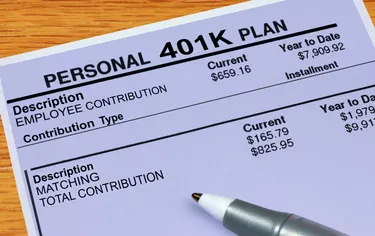
Things You'll Need
Calculator
Publication 17
Warning
If your taxable income plus your 401k plan distribution bumps you into the next income tax bracket, you will pay the higher rate on the part of your 401k plan distribution that falls in that bracket. For example, assume the 25 percent bracket goes up to $80,000 in income and the 30 percent bracket goes from $80,000 to $150,000. If you have $70,000 in taxable income plus a $25,000 401k plan withdrawal, the first $10,000 would be taxed at 25 percent and the last $15,000 would be taxed at 30 percent.
Some employers offer their employees the ability to save pretax dollars for their retirement through 401k plans. When you take a withdrawal from a 401k plan, you must count the amount as part of your taxable income for the year, so you have to plan accordingly to make sure you have enough to pay the taxes. Because the Internal Revenue Service (IRS) treats the withdrawal as part of your taxable income, your rate depends on your income tax bracket. However, the income counts as unearned income so you do not have to pay Federal Insurance Contributions Act or self-employment taxes.
Step 1
Estimate your taxable income for the year. Because the IRS employs a progressive income tax, the amount of tax you pay will be higher for someone who has a high income than someone with a low income. When estimating your taxable income, add all of your taxable income for the year, such as wages, salaries and interest, and subtract any income tax deductions you will claim, such as student loan interest, the standard deduction or the sum of your itemized deductions.
Video of the Day
Step 2
Look up your tax bracket in IRS Publication 17 (see Resources) based on your estimated taxable income. The income tax brackets differ based on your income tax filing status. For example, you will pay a lower rate if you file as head of household than you will if you file as single. For example, if you filed as single for the 2010 tax year with $100,000 of income, you would fall in the 28-percent tax bracket.
Step 3
Multiply the amount of your 401k plan withdrawal by your marginal income tax rate. For example, if you took out $20,000 and fall in a 25-percent income tax bracket, multiply $20,000 by 0.25 to get $5,000 in income taxes.
Step 4
Add a 10 percent penalty to the amount of your federal taxes if you are taking a nonqualified distribution from your 401k plan and do not have an exemption, such as a permanent disability. Nonqualified distributions include all distributions before age 59 and a half. For this example, if you took a nonqualified distribution, multiply 0.1 by $20,000 to get a $2,000 additional income tax penalty.
Step 5
Multiply the amount of your 401k plan withdrawal by your state income tax rate. For example, if your state tax rate equals 5 percent, multiply $20,000 by 0.05 to find you owe $1,000.
Step 6
Add your federal and state taxes along with any early withdrawal penalties to find your total taxes on your 401k plan withdrawal. Completing the example, add $5,000, $2,000 and $1,000 to find the total taxes and penalties equals $8,000.
Video of the Day